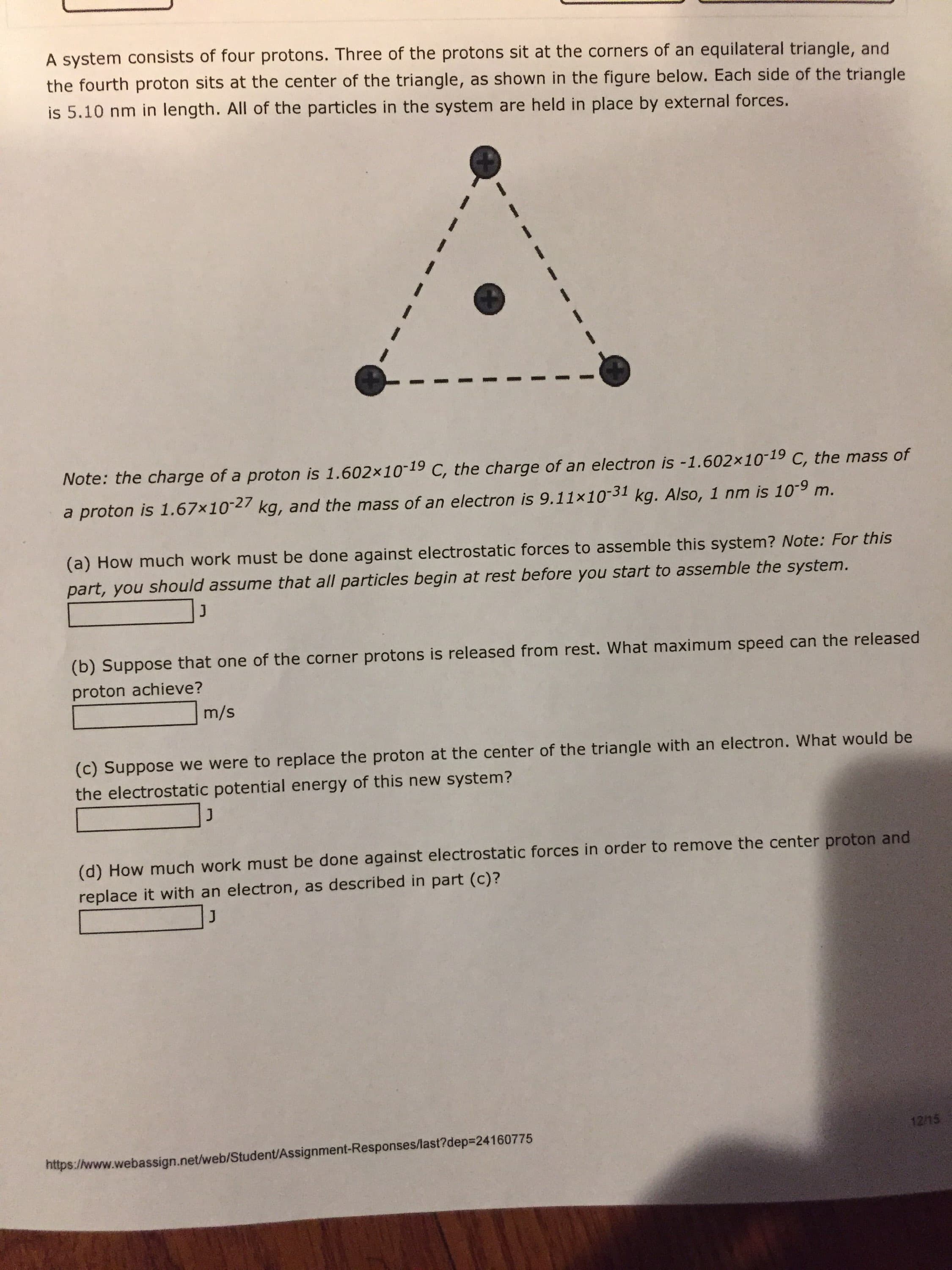A system consists of four protons. Three of the protons sit at the corners of an equilateral triangle, and the fourth proton sits at the center of the triangle, as shown in the figure below. Each side of the triangle is 5.10 nm in length. All of the particles in the system are held in place by external forces. Note: the charge of a proton is 1.602×10-19 C, the charge of an electron is -1.602×10-19 C, the mass of a proton is 1.67×10-27 kg, and the mass of an electron is 9.11×10-31 kg. Also, 1 nm is 10-9 m. (a) How much work must be done against electrostatic forces to assemble this system? Note: For this part, you should assume that all particles begin at rest before you start to assemble the system. (b) Suppose that one of the corner protons is released from rest. What maximum speed can the released proton achieve? m/s (c) Suppose we were to replace the proton at the center of the triangle with an electron. What would be the electrostatic potential energy of this new system? (d) How much work must be done against electrostatic forces in order to remove the center proton and replace it with an electron, as described in part (c)?
A system consists of four protons. Three of the protons sit at the corners of an equilateral triangle, and the fourth proton sits at the center of the triangle, as shown in the figure below. Each side of the triangle is 5.10 nm in length. All of the particles in the system are held in place by external forces. Note: the charge of a proton is 1.602×10-19 C, the charge of an electron is -1.602×10-19 C, the mass of a proton is 1.67×10-27 kg, and the mass of an electron is 9.11×10-31 kg. Also, 1 nm is 10-9 m. (a) How much work must be done against electrostatic forces to assemble this system? Note: For this part, you should assume that all particles begin at rest before you start to assemble the system. (b) Suppose that one of the corner protons is released from rest. What maximum speed can the released proton achieve? m/s (c) Suppose we were to replace the proton at the center of the triangle with an electron. What would be the electrostatic potential energy of this new system? (d) How much work must be done against electrostatic forces in order to remove the center proton and replace it with an electron, as described in part (c)?
Principles of Physics: A Calculus-Based Text
5th Edition
ISBN:9781133104261
Author:Raymond A. Serway, John W. Jewett
Publisher:Raymond A. Serway, John W. Jewett
Chapter19: Electric Forces And Electric Fields
Section: Chapter Questions
Problem 6P
Related questions
Question
Please see the upload images

Transcribed Image Text:A system consists of four protons. Three of the protons sit at the corners of an equilateral triangle, and
the fourth proton sits at the center of the triangle, as shown in the figure below. Each side of the triangle
is 5.10 nm in length. All of the particles in the system are held in place by external forces.
Note: the charge of a proton is 1.602×10-19 C, the charge of an electron is -1.602×10-19 C, the mass of
a proton is 1.67×10-27 kg, and the mass of an electron is 9.11×10-31 kg. Also, 1 nm is 10-9 m.
(a) How much work must be done against electrostatic forces to assemble this system? Note: For this
part, you should assume that all particles begin at rest before you start to assemble the system.
(b) Suppose that one of the corner protons is released from rest. What maximum speed can the released
proton achieve?
m/s
(c) Suppose we were to replace the proton at the center of the triangle with an electron. What would be
the electrostatic potential energy of this new system?
(d) How much work must be done against electrostatic forces in order to remove the center proton and
replace it with an electron, as described in part (c)?
Expert Solution
This question has been solved!
Explore an expertly crafted, step-by-step solution for a thorough understanding of key concepts.
This is a popular solution!
Trending now
This is a popular solution!
Step by step
Solved in 6 steps with 6 images

Knowledge Booster
Learn more about
Need a deep-dive on the concept behind this application? Look no further. Learn more about this topic, physics and related others by exploring similar questions and additional content below.Recommended textbooks for you

Principles of Physics: A Calculus-Based Text
Physics
ISBN:
9781133104261
Author:
Raymond A. Serway, John W. Jewett
Publisher:
Cengage Learning

College Physics
Physics
ISBN:
9781305952300
Author:
Raymond A. Serway, Chris Vuille
Publisher:
Cengage Learning

College Physics
Physics
ISBN:
9781285737027
Author:
Raymond A. Serway, Chris Vuille
Publisher:
Cengage Learning

Principles of Physics: A Calculus-Based Text
Physics
ISBN:
9781133104261
Author:
Raymond A. Serway, John W. Jewett
Publisher:
Cengage Learning

College Physics
Physics
ISBN:
9781305952300
Author:
Raymond A. Serway, Chris Vuille
Publisher:
Cengage Learning

College Physics
Physics
ISBN:
9781285737027
Author:
Raymond A. Serway, Chris Vuille
Publisher:
Cengage Learning

Physics for Scientists and Engineers with Modern …
Physics
ISBN:
9781337553292
Author:
Raymond A. Serway, John W. Jewett
Publisher:
Cengage Learning

Physics for Scientists and Engineers
Physics
ISBN:
9781337553278
Author:
Raymond A. Serway, John W. Jewett
Publisher:
Cengage Learning

Physics for Scientists and Engineers: Foundations…
Physics
ISBN:
9781133939146
Author:
Katz, Debora M.
Publisher:
Cengage Learning